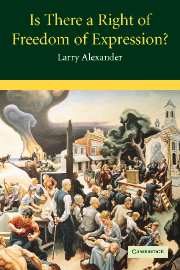Book contents
- Frontmatter
- Contents
- Acknowledgments
- Introduction
- PART ONE DEFINING HUMAN RIGHTS AND DELIMITING THE SCOPE OF FREEDOM OF EXPRESSION
- PART TWO THE CORE OF FREEDOM OF EXPRESSION: GOVERNMENT REGULATIONS AND ACTS TAKEN TO AFFECT MESSAGES
- 4 The Core of Freedom of Expression: Regulations of Conduct for the Purpose of Affecting Messages Received
- 5 Track Three: Government Speech and Subsidies of Speech
- 6 Miscellaneous Regulations of Expression
- PART THREE THEORETICAL PERSPECTIVES ON FREEDOM OF EXPRESSION
- EPILOGUE
- Index
4 - The Core of Freedom of Expression: Regulations of Conduct for the Purpose of Affecting Messages Received
Published online by Cambridge University Press: 07 January 2010
- Frontmatter
- Contents
- Acknowledgments
- Introduction
- PART ONE DEFINING HUMAN RIGHTS AND DELIMITING THE SCOPE OF FREEDOM OF EXPRESSION
- PART TWO THE CORE OF FREEDOM OF EXPRESSION: GOVERNMENT REGULATIONS AND ACTS TAKEN TO AFFECT MESSAGES
- 4 The Core of Freedom of Expression: Regulations of Conduct for the Purpose of Affecting Messages Received
- 5 Track Three: Government Speech and Subsidies of Speech
- 6 Miscellaneous Regulations of Expression
- PART THREE THEORETICAL PERSPECTIVES ON FREEDOM OF EXPRESSION
- EPILOGUE
- Index
Summary
Having shown in Chapter Two, primarily through an excursion into American First Amendment jurisprudence and its Track Two component, but with some glances at the analogous jurisprudence of Canada and Australia, that principles (1), (2), (3), and (4) – all of which focus on the effects of regulations on messages intended and received – are untenable for delimiting the scope of freedom of expression, I concluded that principle (5), which has as its focus the regulator's purpose in regulating conduct, defines that scope. Principle (5) includes within freedom of expression all conduct that is restricted for the purpose of affecting the messages that audiences receive. It is immaterial under principle (5) whether the conduct is the conventional method of expressing ideas – written or oral language – whether it is intended to express ideas by those engaging in it, or whether most people would receive the message in question from observing or hearing the conduct. All that matters is why the conduct is regulated. If it is regulated because of a message that the regulator wishes to suppress, alter, or otherwise affect, freedom of expression is implicated. Thus, if government forbids people from climbing Half Dome in Yosemite National Park – not because of the danger that they might be injured, not because of the harm they might cause the environment, but because government fears that some of them are receiving spiritual messages from the experience that the government wishes them not to receive – freedom of expression is in issue despite the absence of a speaker, an intent to speak, conventional symbols, and perhaps even the meaning most would attach to the experience.
- Type
- Chapter
- Information
- Is There a Right of Freedom of Expression? , pp. 55 - 81Publisher: Cambridge University PressPrint publication year: 2005



